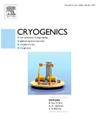Impact of fibre reinforcement on cryogenic performance of novel epoxy composites for cryogenic applications
IF 1.8
3区 工程技术
Q3 PHYSICS, APPLIED
引用次数: 0
Abstract
Due to the dynamic development of technology and science, there is an increasing demand for materials combining high mechanical resistance to extreme temperature conditions and suitable thermal properties. Especially the knowledge of heat transfers by conduction and thermal radiation is crucial for the successful design of devices operating at cryogenic temperatures, such as Dewars, cryostats, or space probes. This study aimed to assess important thermal and mechanical properties at cryogenic temperatures for three composite materials made of identical epoxy resin reinforced by carbon, basalt or glass fibres. Apart from loading/unloading cyclic tensile tests conducted at room temperature and in cryogenic environments at 77 K, thermal conductivity and total hemispherical emissivity were obtained in wide temperature ranges from 5 K up to 300 K. The results highlighted the importance of the fibre material and have potential to help with optimal material selection. We found that the initial stiffness of the laminates increased at low temperatures, and the glass composite exhibited the best mechanical properties. On the other hand, the carbon composite showed the lowest but steeply increasing thermal conductivity with increasing temperature. This, together with the lowest emissivity, makes the carbon composite a more favourable option for the lowest temperatures.
纤维增强对新型环氧复合材料低温性能的影响
由于技术和科学的动态发展,人们对材料的需求越来越大,这种材料既能抵抗极端温度条件,又能抵抗适当的热性能。特别是通过传导和热辐射传热的知识对于在低温下工作的设备的成功设计至关重要,例如杜瓦,低温恒温器或太空探测器。本研究旨在评估由碳、玄武岩或玻璃纤维增强的相同环氧树脂制成的三种复合材料在低温下的重要热性能和机械性能。除了在室温和77 K低温环境下进行的加载/卸载循环拉伸试验外,还获得了从5 K到300 K的宽温度范围内的导热系数和总半球形发射率。结果强调了纤维材料的重要性,并有可能帮助优化材料选择。结果表明,在低温条件下,层合板的初始刚度增大,玻璃复合材料的力学性能最好。另一方面,随着温度的升高,碳复合材料的导热系数最低,但急剧增加。这一点,再加上最低的发射率,使碳复合材料成为最低温度下更有利的选择。
本文章由计算机程序翻译,如有差异,请以英文原文为准。
求助全文
约1分钟内获得全文
求助全文
来源期刊

Cryogenics
物理-热力学
CiteScore
3.80
自引率
9.50%
发文量
0
审稿时长
2.1 months
期刊介绍:
Cryogenics is the world''s leading journal focusing on all aspects of cryoengineering and cryogenics. Papers published in Cryogenics cover a wide variety of subjects in low temperature engineering and research. Among the areas covered are:
- Applications of superconductivity: magnets, electronics, devices
- Superconductors and their properties
- Properties of materials: metals, alloys, composites, polymers, insulations
- New applications of cryogenic technology to processes, devices, machinery
- Refrigeration and liquefaction technology
- Thermodynamics
- Fluid properties and fluid mechanics
- Heat transfer
- Thermometry and measurement science
- Cryogenics in medicine
- Cryoelectronics
 求助内容:
求助内容: 应助结果提醒方式:
应助结果提醒方式:


